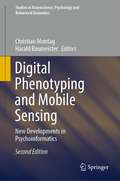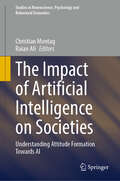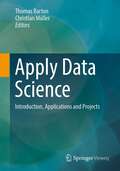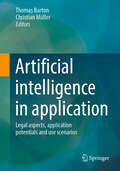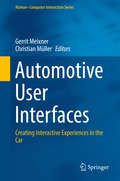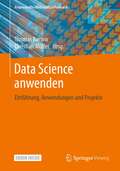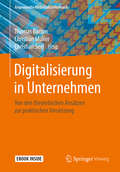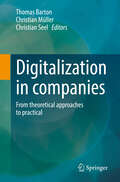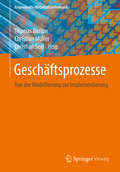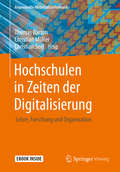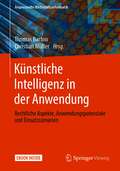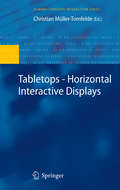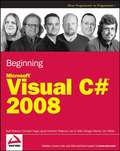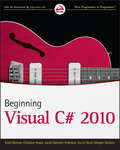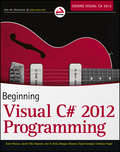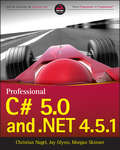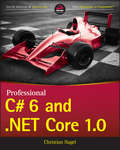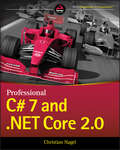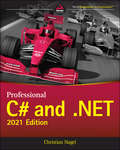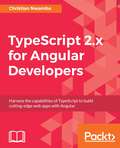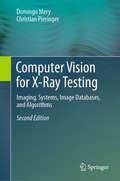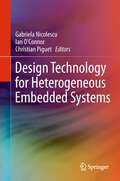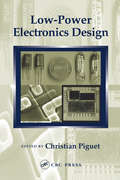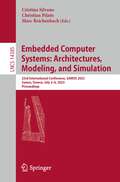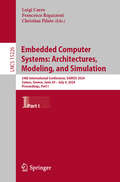- Table View
- List View
Digital Phenotyping and Mobile Sensing: New Developments in Psychoinformatics (Studies in Neuroscience, Psychology and Behavioral Economics)
by Christian Montag Harald BaumeisterThis book offers a snapshot of cutting-edge applications of digital phenotyping and mobile sensing for studying human behavior and planning innovative e-healthcare interventions. The respective chapters, written by authoritative researchers, cover both theoretical perspectives and good scientific and professional practices related to the use and development of these technologies. They share novel insights into established applications of mobile sensing, such as predicting personality or mental and behavioral health on the basis of smartphone usage patterns, and highlight emerging trends, such as the use of machine learning, big data and deep learning approaches, and the combination of mobile sensing with AI and expert systems. Important issues relating to privacy and ethics are analyzed, together with selected case studies. This thoroughly revised and extended second edition provides researchers and professionals with extensive information on the latest developments in the field of digital phenotyping and mobile sensing. It gives a special emphasis to trends in diagnostics systems and AI applications, suggesting important future directions for research in public health and social sciences.
The Impact of Artificial Intelligence on Societies: Understanding Attitude Formation Towards AI (Studies in Neuroscience, Psychology and Behavioral Economics)
by Christian Montag Raian AliThis book presents a recent framework proposed to understand how attitudes towards artificial intelligence are formed. It describes how the interplay between different variables, such as the modality of AI interaction, the user personality and culture, the type of AI applications (e.g. in the realm of education, medicine, transportation, among others), and the transparency and explainability of AI systems contributes to understand how user's acceptance or a negative attitude towards AI develops. Gathering chapters from leading researchers with different backgrounds, this book offers a timely snapshot on factors that will be influencing the impact of artificial intelligence on societies. Chapter 12 is available open access under a Creative Commons Attribution 4.0 International License via link.springer.com.
Apply Data Science: Introduction, Applications and Projects
by Thomas Barton Christian MüllerThis book offers an introduction to the topic of data science based on the visual processing of data. It deals with ethical considerations in the digital transformation and presents a process framework for the evaluation of technologies. It also explains special features and findings on the failure of data science projects and presents recommendation systems in consideration of current developments. Machine learning functionality in business analytics tools is compared and the use of a process model for data science is shown.The integration of renewable energies using the example of photovoltaic systems, more efficient use of thermal energy, scientific literature evaluation, customer satisfaction in the automotive industry and a framework for the analysis of vehicle data serve as application examples for the concrete use of data science. The book offers important information that is just as relevant for practitioners as for students and teachers.
Artificial intelligence in application: Legal aspects, application potentials and use scenarios
by Thomas Barton Christian MüllerThe book shows application potentials of artificial intelligence in various industries and presents application scenarios on how a practical implementation can take place. The starting point is the description of legal aspects, which includes a European regulation for artificial intelligence and addresses the question of the permissibility of automated decisions. The description of various application potentials, mostly industry-related, and the presentation of some application scenarios form the focus of the topic volume. The book is based on the question of how artificial intelligence can be used in entrepreneurial practice. It offers important information that is just as relevant for practitioners as for students and teachers. This book is a translation of an original German edition. The translation was done with the help of artificial intelligence (machine translation by the service DeepL.com). A subsequent human revision was done primarily in terms of content, so that the book will read stylistically differently from a conventional translation.
Automotive User Interfaces: Creating Interactive Experiences in the Car (Human–Computer Interaction Series)
by Christian Müller Gerrit MeixnerThis book focuses on automotive user interfaces for in-vehicle usage, looking at car electronics and its software of hidden technologies (e. g. , ASP, ESP), comfort functions (e. g. , navigation, communication, entertainment) and driver assistance (e. g. , distance checking). The increased complexity of automotive user interfaces, driven by the need for using consumer electronic devices in cars as well as autonomous driving, has sparked a plethora of new research within this field of study. Covering a broad spectrum of detailed topics, the authors of this edited volume offers an outstanding overview of the current state of the art; providing deep insights into usability and user experience, interaction techniques and technologies as well as methods, tools and its applications; exploring the increasing importance of Human-Computer-Interaction (HCI) within the automotive industry. Automotive User Interfaces is intended as an authoritative and valuable resource for professional practitioners and researchers alike, as well as computer science and engineering students who are interested in automotive interfaces.
Data Science anwenden: Einführung, Anwendungen und Projekte (Angewandte Wirtschaftsinformatik)
by Thomas Barton Christian MüllerDieses Buch bietet einen Einstieg in das Thema Data Science auf Basis der visuellen Aufbereitung von Daten. Es hat ethische Betrachtungen in der digitalen Transformation zum Gegenstand und stellt ein Prozessrahmenwerk für die Bewertung von Technologien vor. Außerdem erläutert es Besonderheiten und Erkenntnisse zum Scheitern von Data-Science-Projekten und stellt Empfehlungssysteme unter Berücksichtigung aktueller Entwicklungen vor. Funktionalität zu Machine Learning in Werkzeugen zu Business Analytics wird verglichen und der Einsatz eines Vorgehensmodells für Data Science aufgezeigt.Die Integration erneuerbarer Energien am Beispiel von Photovoltaikanlagen, ein effizienterer Umgang mit Wärmeenergie, wissenschaftliche Literaturauswertung, Kundenzufriedenheit in der Automobilindustrie und ein Framework für die Analyse von Fahrzeugdaten dienen als Anwendungsbeispiele für den konkreten Einsatz von Data Science. Das Buch bietet wichtige Informationen, die für Praktiker ebenso relevant sind wie für Studierende und Lehrende.
Digitalisierung in Unternehmen: Von den theoretischen Ansätzen zur praktischen Umsetzung (Angewandte Wirtschaftsinformatik)
by Thomas Barton Christian Müller Christian SeelDas Buch vermittelt aktuelle Ansätze der Digitalisierung in Unternehmen und zeigt auf, wie Digitalisierungsprojekte erfolgreich und sicher in der Praxis umgesetzt werden. Ausgehend von der Beschreibung einer sich wandelnden Wertschöpfung und Arbeitswelt wird anhand von Anwendungsszenarien dargelegt, welche Änderungen mit der Digitalisierung einhergehen: Neue Geschäftsmodelle und Geschäftsprozesse etablieren sich, die Entwicklung von Produkten verändert sich ebenso wie die Interaktion mit Kunden, neue Chancen aber auch neue Risiken entstehen. Die Beitragsautoren stellen dabei Grundlagen als auch Konzepte vor, um die Digitalisierung von Prozessen und Anwendungen konkret zu planen und durchzuführen. Auch Aspekte der IT-Sicherheit kommen dabei nicht zu kurz. Das Herausgeberwerk basiert auf Fragestellungen aus der unternehmerischen Praxis und eignet sich auch für Studierende und Lehrende.
Digitalization in companies: From theoretical approaches to practical
by Thomas Barton Christian Müller Christian SeelThe book conveys current approaches to digitization in companies and shows how digitization projects can be successfully and safely implemented in practice. Based on the description of a changing value creation and working world, the changes associated with digitization are explained using application scenarios: New business models and business processes are being established, the development of products is changing as is the interaction with customers, new opportunities but also new risks are emerging. The authors of the article present the basics as well as concepts for the concrete planning and implementation of the digitization of processes and applications. Aspects of IT security are not neglected either. The editors' work is based on questions from entrepreneurial practice and is also suitable for students and teachers.
Geschäftsprozesse
by Thomas Barton Christian Müller Christian SeelDas Buch vermittelt Konzepte, zeigt aktuelle Trends wie agile Methoden, stellt Anwendungsszenarien für die Modellierung und Implementierung von Geschäftsprozessen im Zeitalter der Digitalisierung vor. Das Herausgeberwerk basiert dabei auf Fragestellungen aus der unternehmerischen Praxis. Schwerpunkte sind innovative Analysemethoden, kontextsensitive und wissensintensive Geschäftsprozesse sowie aktuelle Ansätze bei der Umsetzung. Fallstudien runden das Buch ab. Es wendet sich sowohl an Berater und Projektverantwortliche als auch an Studierende und Lehrende.
Hochschulen in Zeiten der Digitalisierung: Lehre, Forschung und Organisation (Angewandte Wirtschaftsinformatik)
by Thomas Barton Christian Müller Christian SeelDigitalisierung für Hochschulen – Dieses Buch zeigt, wie es gehtIn diesem Buch erfahren Sie alles zu Digitalisierungsprozessen an Hochschulen und Universitäten. Die Autoren erläutern die Herausforderungen für Lehre, Forschung und die interne Organisation und präsentieren ihre Lösungen zu: Digitalisierung von HochschulprozessenDigitalisierung des Studiums (der Forschung, Lehre und des Lernens)Informationssysteme an HochschulenAnwendungsszenarienDas Buch richtet sich in erster Linie an Führungskräfte und Lehrende im Hochschulbetrieb, aber ebenso an Projektleiter, Projektmitarbeiter und interessierte Studierende.Universität 4.0: Lernen Sie in diesem Buch neue Digitalisierungsstrategien für HochschulenDank vieler Beispiele und praxisnahen Anwendungen vermittelt Ihnen dieses Buch ein Gefühl für die Problematik und stellt verschiedene Digitalisierungskonzepte vor, welche die digitale Lehre in Hochschulen positiv beeinflussen können. Werfen Sie gemeinsam mit Prof. Dr. Thomas Barton, Prof. Dr. Christian Müller und Prof. Dr. Christian Seel einen Blick auf die vielfältigen Einsatzgebiete der Digitalisierung, wie: elektronische PrüfungeneLearning (u. a. MOOCs)die digitale Abgabe von Hausarbeitender Einsatz von Podcastselektronische AbstimmungssystemeAugmented RealityDas Buch zeigt Ihnen, dass die Digitalisierung gleichermaßen Auswirkungen auf das Hochschulmanagement und die Wissenschaft hat, wie etwa die Forschung und die dazugehörigen Forschungsprozesse.
Künstliche Intelligenz in der Anwendung: Rechtliche Aspekte, Anwendungspotenziale und Einsatzszenarien (Angewandte Wirtschaftsinformatik)
by Thomas Barton Christian MüllerDas Buch zeigt Anwendungspotenziale von Künstlicher Intelligenz in verschiedenen Branchen und stellt Einsatzszenarien vor, wie eine praktische Umsetzung erfolgen kann. Ausgangsbasis ist die Beschreibung rechtlicher Aspekte, die eine europäische Regelung für Künstliche Intelligenz umfasst und die Frage nach der Zulässigkeit automatisierter Entscheidungen zum Gegenstand hat. Die Beschreibung verschiedener meist branchenbezogener Anwendungspotenziale und die Vorstellung einiger Einsatzszenarien bilden den Schwerpunkt des Themenbandes. Das Buch basiert auf der Fragestellung, wie Künstliche Intelligenz in der unternehmerischen Praxis eingesetzt werden kann. Es bietet wichtige Informationen, die für Praktiker ebenso relevant sind wie für Studierende und Lehrende.
Tabletops - Horizontal Interactive Displays
by Christian Müller-TomfeldeThis book is the first attempt to bring together current research findings in the domain of interactive horizontal displays. The novel compilation will integrate and summarise findings from the most important international tabletop research teams. It will provide a state-of-the art overview of this research domain and therefore allow for discussion of emerging and future directions in research and technology of interactive horizontal displays. Latest advances in interaction and software technologies and their increasing availability beyond research labs, refuels the interest in interactive horizontal displays. In the early 1990s Mark Weiser's vision of Ubiquitous Computing redefined the notion of Human Computer Interaction. Interaction was no longer considered to happen only with standard desktop computers but also with elements of their environment. This book is structured in three major areas: 'under', 'on/above' and 'around' tabletops. These areas are associated with different research disciplines such as Hardware/Software and Computer Science, Human Computer Interaction (HCI) and Computer Supported Collaborative Work (CSCW). However, the comprehensive and compelling presentation of the topic of the book results from its interdisciplinary character. The book addresses fellow researchers who are interested in this domain and practitioners considering interactive tabletops in real-world projects. It will also be a useful introduction into tabletop research that can be used for the academic curriculum.
Beginning Microsoft Visual C# 2008
by Christian Nagel Karli Watson Morgan Skinner Jacob Hammer Pedersen Jon D. Reid Eric WhiteThe book is aimed at novice programmers who wish to learn programming with C# and the .NET framework. The book starts with absolute programming basics. It then moves into Web and Windows programming, data access (databases and XML), and more advanced technologies such as graphics programming with GDI+ and basic networking. The book is divided into sections including:The C# Language: Basic language skills using console application. Content moves from the absolute basics to fairly involved OOP skills.Windows Vista Programming: Using basic Windows applications, reinforcing earlier OOP and debugging skills.Web Programming: Putting together basic Web applications, highlighting differences between Web and Windows programming.Data Access: Accessing all kinds of data sources from Web and Windows applications, including SQL usage, XML, file system data, and Web Services.Additional Techniques: "The fun stuff", including Windows Presentation Foundation, Windows Workflow, Windows Communication Foundation, GDI+, networking, Windows Services, and so on.The book makes complicated subjects seem easy to learn, and it inspires readers to investigate areas further on their own by providing references to additional material, and exercise questions that require significant effort and personal research to complete.
Beginning Visual C# 2010
by Christian Nagel Karli Watson Morgan Skinner Jacob Hammer Pedersen Jon D. ReidUpdate to Wrox's leading C# book for beginners Get ready for the next release of Microsoft's C# programming language with this essential Wrox beginner's guide. Beginning Microsoft Visual C# 2010 starts with the basics and brings you thoroughly up to speed. You'll first cover the fundamentals such as variables, flow control, and object-oriented programming and gradually build your skills for Web and Windows programming, Windows forms, and data access. Step-by-step directions walk you through processes and invite you to "Try it Out," at every stage. By the end, you'll be able to write useful programming code following the steps you've learned in this thorough, practical book. The C# 4 programming language version will be synonymous with writing code with in C# 2010 in Visual Studio 2010, and you can use it to write Windows applications, Web apps with ASP. NET, and Windows Mobile and Embedded CE apps Provides step-by-step instructions for mastering topics such as variables, flow controls, and object-oriented programming before moving to Web and Windows programming and data access Addresses expressions, functions, debugging, error handling, classes, collections, comparisons, conversions, and more If you've always wanted to master Visual C# programming, this book is the perfect one-stop resource. Note: CD-ROM/DVD and other supplementary materials are not included as part of eBook file.
Beginning: Visual C#® 2012 Programming
by Christian Nagel Karli Watson Morgan Skinner Jacob Vibe Hammer John D. Reid Daniel KemperStep-by-step beginner's guide to Visual C# 2012 Written for novice programmers who want to learn programming with C# and the . NET framework, this book offers programming basics such as variables, flow control, and object oriented programming. It then moves into web and Windows programming and data access (databases and XML). The authors focus on the tool that beginners use most often to program C#, the Visual C# 2012 development environment in Visual Studio 2012. Puts the spotlight on key beginning level topics with easy-to-follow instructions for Microsoft Visual C# 2012 Explores how to program for variables, expressions, flow control, and functions Explains the debugging process and error handling as well as object oriented programming, and much more Beginning Microsoft Visual C# 2012 Programming offers beginners a guide to writing effective programming code following simple step-by-step methods, each followed by the opportunity to try out newly acquired skills.
Professional C# 5.0 and .NET 4.5.1
by Christian Nagel Jay Glynn Morgan SkinnerComprehensive, advanced coverage of C# 5.0 and .NET 4.5.1Whether you're a C# guru or transitioning from C/C++, staying up to date is critical to your success. Professional C# 5.0 and .NET 4.5.1 is your go-to guide for navigating the programming environment for the Windows platform. After a quick refresher of the C# basics, the team of expert authors dives in to C# 5.0 and updates for NET 4.5.1. Includes:Different behaviors for .NET 4.5.1 and the changes to Visual Studio 2013Changes to ASP.NET Core, Web Forms, MVC, and Web APIUpdated Windows 8 deployments and localization, event logs, and data flowShuffling of ADO.NET Entity FrameworkAdditions to Windows Workflow FoundationNew Windows Runtime 2.0 updates
Professional C# 6 and .NET Core 1.0
by Christian NagelA true professional's guide to C# 6 Professional C# 6 and .NET Core 1.0 provides complete coverage of the latest updates, features, and capabilities, giving you everything you need for C#. Get expert instruction on the latest changes to Visual Studio 2015, Windows Runtime, ADO.NET, ASP.NET, Windows Store Apps, Windows Workflow Foundation, and more, with clear explanations, no-nonsense pacing, and valuable expert insight. This incredibly useful guide serves as both tutorial and desk reference, providing a professional-level review of C# architecture and its application in a number of areas. You'll gain a solid background in managed code and .NET constructs within the context of the 2015 release, so you can get acclimated quickly and get back to work. The new updates can actively streamline your workflow, with major changes including reimagined C# refactoring support, a new .NET Web app stack, and the .NET compiler platform that makes C# and Visual Basic compilers available as APIs. This book walks you through the changes with a comprehensive C# review. Explore the new Visual Studio templates for ASP.NET Core 1.0, Web Forms, and MVC Learn about the networking switch to HttpClient and ASP.NET Web API's replacement of WCF Data Services Work with the latest updates to the event log, Windows Runtime 2.0, and Windows 8.1 deployment and localization Dig deep into the new .NET 5.0 GC behaviors and the Migrations addition to ADO.NET Microsoft has stepped up both the cadence and magnitude of their software releases. Professional C# 6 and .NET Core 1.0 shows you everything you need to know about working with C# in a real-world context.
Professional C# 7 and .NET Core 2.0
by Christian NagelThe professional’s guide to C# 7, with expert guidance on the newest features Professional C# 7 and .NET Core 2.0 provides experienced programmers with the information they need to work effectively with the world’s leading programming language. The latest C# update added many new features that help you get more done in less time, and this book is your ideal guide for getting up to speed quickly. C# 7 focuses on data consumption, code simplification, and performance, with new support for local functions, tuple types, record types, pattern matching, non-nullable reference types, immutable types, and better support for variables. Improvements to Visual Studio will bring significant changes to the way C# developers interact with the space, bringing .NET to non-Microsoft platforms and incorporating tools from other platforms like Docker, Gulp, and NPM. Guided by a leading .NET expert and steeped in real-world practicality, this guide is designed to get you up to date and back to work. With Microsoft speeding up its release cadence while offering more significant improvement with each update, it has never been more important to get a handle on new tools and features quickly. This book is designed to do just that, and more—everything you need to know about C# is right here, in the single-volume resource on every developer’s shelf. Tour the many new and enhanced features packed into C# 7 and .NET Core 2.0 Learn how the latest Visual Studio update makes developers’ jobs easier Streamline your workflow with a new focus on code simplification and performance enhancement Delve into improvements made for localization, networking, diagnostics, deployments, and more Whether you’re entirely new to C# or just transitioning to C# 7, having a solid grasp of the latest features allows you to exploit the language’s full functionality to create robust, high -quality apps. Professional C# 7 and .NET Core 2.0 is the one-stop guide to everything you need to know.
Professional C# and .NET
by Christian NagelGet the latest coverage of the newest features in C#9 and .NET 5 In Professional C# and .NET: 2021 Edition, Microsoft MVP for Visual Studio and Development Technologies and veteran developer, Christian Nagel, delivers a comprehensive tour of the new features and capabilities of C#9 and .NET 5. Experienced programmers making the transition to C# will benefit from the author’s in-depth explorations to create Web- and Windows applications using ASP.NET Core, Blazor, and WinUI using modern application patterns and new features offered by .NET including Microservices deployed to Docker images, GRPC, localization, asynchronous streaming, and much more. The book also offers: Discussions of the extension of .NET to non-Microsoft platforms like OSX and Linux Explanations of the newest features in C#9, including support for record types, and enhanced support for tuples, pattern matching, and nullable reference types Integrating .NET applications with Microsoft Azure services such as Azure App Configuration, Azure Key Vault, Azure Functions, the Azure Active Directory, and others Downloadable code examples from wrox.com and github.com with online updates for C# 10 and .NET 6 Perfect for programmers with a background in C#, Visual Basic, Java, or C/C++, Professional C# and .NET: 2021 Edition will also earn a place in the libraries of software architects seeking an up-to-date and fulsome treatment of the latest C# and .NET releases.
TypeScript 2.x for Angular Developers
by Christian NwambaWrite better, reusable, and predictable Angular apps with typed logic About This Book • Leverage the power of TypeScript for developing large-scale Angular apps • Take advantage of the cutting-edge features of TypeScript 2.x to build high-performing, maintainable applications • Explore the TypeScript implementation of modules, classes, and annotations with Angular components Who This Book Is For This book is for developers who would like to learn to use TypeScript to develop Angular applications. A basic JavaScript knowledge would be beneficial. What You Will Learn • Move from loose types to predictable strict types • Write self-documented API methods and data structures • Understand custom generic types for complex data structures • Implement Contract with Interfaces • Enhance Dependency Injection in Angular via class constructors • Explore TypeScript advanced types • Build Interactive web apps with Angular and TypeScript In Detail TypeScript, a superset of JavaScript, is the default language for building Angular applications from Google. TypeScript 2.0 adds optional static types, classes, and modules to JavaScript, to enable great tooling and better structuring of large JavaScript applications. This book will teach you how to leverage the exciting features of TypeScript while working on Angular projects to build scalable, data-intensive web applications. You will begin by setting up and installing TypeScript and then compile it with JavaScript. You will then learn to write simple JavaScript expressions with TypeScript. You will then go through some built in TypeScript types and accessors. Further you will build web components using TypeScript Interfaces and Decorators. You will go through the Angular form module, which will enable you to write predictable typed forms with TypeScript and learn to use typed DOM events. You will also build a single-page application using the Router module. Lastly, you will consume API data with Angular's HTTP Module and handle responses with RxJS observables. At the end of the book, you will go through different testing and debugging techniques. Style and approach A step-by-step, tutorial-based guide
Computer Vision for X-Ray Testing: Imaging, Systems, Image Databases, and Algorithms
by Domingo Mery Christian Pieringer[FIRST EDITION] This accessible textbook presents an introduction to computer vision algorithms for industrially-relevant applications of X-ray testing. Features: introduces the mathematical background for monocular and multiple view geometry; describes the main techniques for image processing used in X-ray testing; presents a range of different representations for X-ray images, explaining how these enable new features to be extracted from the original image; examines a range of known X-ray image classifiers and classification strategies; discusses some basic concepts for the simulation of X-ray images and presents simple geometric and imaging models that can be used in the simulation; reviews a variety of applications for X-ray testing, from industrial inspection and baggage screening to the quality control of natural products; provides supporting material at an associated website, including a database of X-ray images and a Matlab toolbox for use with the book’s many examples.
Design Technology for Heterogeneous Embedded Systems
by Ian O'Connor Gabriela Nicolescu Christian PiguetDesign technology to address the new and vast problem of heterogeneous embedded systems design while remaining compatible with standard "More Moore" flows, i.e. capable of simultaneously handling both silicon complexity and system complexity, represents one of the most important challenges facing the semiconductor industry today and will be for several years to come. While the micro-electronics industry, over the years and with its spectacular and unique evolution, has built its own specific design methods to focus mainly on the management of complexity through the establishment of abstraction levels, the emergence of device heterogeneity requires new approaches enabling the satisfactory design of physically heterogeneous embedded systems for the widespread deployment of such systems. Heterogeneous Embedded Systems, compiled largely from a set of contributions from participants of past editions of the Winter School on Heterogeneous Embedded Systems Design Technology (FETCH), proposes a necessarily broad and holistic overview of design techniques used to tackle the various facets of heterogeneity in terms of technology and opportunities at the physical level, signal representations and different abstraction levels, architectures and components based on hardware and software, in all the main phases of design (modeling, validation with multiple models of computation, synthesis and optimization). It concentrates on the specific issues at the interfaces, and is divided into two main parts. The first part examines mainly theoretical issues and focuses on the modeling, validation and design techniques themselves. The second part illustrates the use of these methods in various design contexts at the forefront of new technology and architectural developments.
Low-Power Electronics Design (Computer Engineering Series)
by Christian PiguetThe power consumption of integrated circuits is one of the most problematic considerations affecting the design of high-performance chips and portable devices. The study of power-saving design methodologies now must also include subjects such as systems on chips, embedded software, and the future of microelectronics. Low-Power Electronics Design covers all major aspects of low-power design of ICs in deep submicron technologies and addresses emerging topics related to future design. This volume explores, in individual chapters written by expert authors, the many low-power techniques born during the past decade. It also discusses the many different domains and disciplines that impact power consumption, including processors, complex circuits, software, CAD tools, and energy sources and management. The authors delve into what many specialists predict about the future by presenting techniques that are promising but are not yet reality. They investigate nanotechnologies, optical circuits, ad hoc networks, e-textiles, as well as human powered sources of energy. Low-Power Electronics Design delivers a complete picture of today's methods for reducing power, and also illustrates the advances in chip design that may be commonplace 10 or 15 years from now.
Embedded Computer Systems: 23rd International Conference, SAMOS 2023, Samos, Greece, July 2–6, 2023, Proceedings (Lecture Notes in Computer Science #14385)
by Cristina Silvano Marc Reichenbach Christian PilatoThis book constitutes the proceedings of the 22st International Conference on Embedded Computer Systems: Architectures, Modeling, and Simulation, SAMOS 2021, which took place in July 2022 in Samos, Greece. The 11 full papers and 7 short papers presented in this volume were carefully reviewed and selected from 45 submissions. The conference covers a wide range of embedded systems design aspects, including machine learning accelerators, and power management and programmable dataflow systems.
Embedded Computer Systems: 24th International Conference, SAMOS 2024, Samos, Greece, June 29 – July 4, 2024, Proceedings, Part I (Lecture Notes in Computer Science #15226)
by Luigi Carro Francesco Regazzoni Christian PilatoThe two-volume set LNCS 15226 and 15227 constitutes the refereed proceedings of the 24th International Conference on Embedded Computer Systems: Architectures, Modeling, and Simulation, SAMOS 2024, held in Samos, Greece, during June 29–July 4, 2024. The 24 full papers, 10 full papers in 2 special sessions and 4 poster session included in this book were carefully reviewed and selected from 57 submissions. This SAMOS 2024 covers the topics systems themselves - through their applications; architectures; and underlying processors - or methods created to automate their design.
